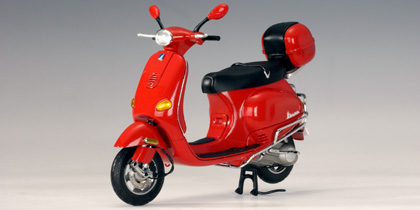
Shared Knowledge
"Vespa ET-4 - Routine Maintenance"
12 April 2009

Summary: Routine Vespa ET-4 maintenance is certainly a do-it-yourself (DIY) for someone with some tools and patience.
Oil Change.
Changing
oil is much harder and a much messier job than it should be
(perhaps Vespa has solved this problem on newer models). According to the shop manual, you are
supposed to completely remove the muffler from the scooter and then use a 24mm
socket or wrench on the large oil drain plug which is on the rider’s right
side, directly behind the muffler.Could Vespa have put the oil drain plug in a harder location to get to? Anyway, I have found that if you do remove
the bolts holding the muffler to the engine and frame and then loosen the 2
nuts holding the muffler to the exhaust manifold, you will be able to move the
muffler out of the way enough to get a 24mm wrench on the drain plug and also
get your hand in behind the muffler to hand unscrew the oil filter. Note that there is a small screen type
filter inside the oil drain plug hole and it might fall out when you finally
get the drain plug out. If it falls
out, make sure you reinsert it, open end towards you, back into the hole before
putting the drain plug back in. Also
note that I have yet to figure out a way to keep some oil from dripping down
and not getting into my oil pan. Seems
like the drain plug is so close to the rear kickstand it is impossible to
really position a drain pan right under the plug to catch all the oil. Maybe you can come up with a good way of
catching all the oil. The oil filter
might be on tight to begin with but with a small oil filter wrench, you should
be able to get it off. Once you have a
new oil filter on and the drain plug tighten back up, you refill oil on the
rider’s left side and the system takes exactly 1 US quart of oil with a filter
change.
Air Filter.
Changing
the air filter is also harder than it should be. The air filter is located on the rider’s left side right up under
the rear cowling. Bolts are used to
hold the air filter cover in place and some nuts can be tough to get to but it
can be done either from up under the outside or down through the hole under the
seat after you remove the plastic carrying bucket, which is located there. Sometimes, rather than hassle trying to get
my hand up under the cowling back there, I simply remove the lower piece of
cowling which is only held one with 2 bolts.
Spark Plug. Spark
plug replacement is no different than the other 2 maintenance procedures
already described. The plug sits at
about a 30-degree angle to the centerline of the scooter, the wire attachment
tip towards the front of the scooter but the plug tilted down into the head at
about a 15-degree angle. It is pretty
deep inside the hole under the seat and tough to get to and to get a spark plug
wrench on but it is possible. Here,
having hands, which can “see” really helps as taking the plug out and inserting
a new one, really has to be done by feel. I have changed the plug one time and am not looking forward to the next
change. Also the plugs are strange and
rare and not available at your local auto parts store. They carry a special “made for Vespa” number
on them, which I have yet to find any sort of translation chart, which shows me
what other “Champion” or other brand plug I could use. So far, I have bought plugs from a Vespa
dealer although they have been out of them one or more times I have asked about
acquiring spares to keep here in my garage.
Rear Drum Break Adjustment. Because it is a drum-type brake, the rear brake requires cable adjustment from time to time. Do not want to squeeze rear brake lever on handlebars and get nothing. Oh, how I wish Vespa had installed a rotor and calipers on the rear wheel instead of the drum brake and cable. Adjustment of the rear brake cable is easy as the cable is threaded through 2 nuts and you simply loosen one nut, use a wrench to move the nut closest to the front of the scooter towards the front, spin the rear wheel up on the rear stand and then try the rear hand brake and see what you have. If the wheel spins freely when the hand brake is not applied but tights down nicely when the hand brake is applied, then simply wrench up the second nut until it is snug against the first nut so neither nut can move on the cable.
Keeping Battery Charged. My Vespa can sit for long periods of time between rids and thus have already had to replace the small battery twice. Inactivity ruins a small battery. To prevent this, I procured a Battery Tender that is connected to the battery anytime I am not riding this. I highly recommend this device for all Vespa scooters or even motorcycles of any kind.
Click here for more Vespa ET-4